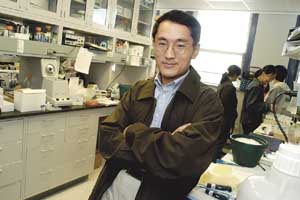Gene ‘traffic’ study overturns claims of earlier research
By Catherine GianaroMedical Center Public Affairs
 Manyuan Long |
Researchers at the University have discovered there is extensive gene “traffic”—the process of genes leaving and arriving on the chromosome—on the mammalian X chromosome. They also have overturned a conventional theory about how genes evolved on the sex chromosome.
The researchers’ study, published in the Jan. 23 issue of Science, shows an excess of genes on the X chromosome “jump” to a non-sex chromosome, or autosome, during germ-line cell division. This finding contradicts the historic human genome project paper, published in 2001, which claimed the X chromosome had an average rate of traffic similar to all autosomes. The discovery also torpedoes the conventional theory that the X chromosome is the ‘hot bed’ for sex-related genes.
“That’s just not true,” said the leader of the study, Manyuan Long, Associate Professor in Ecology & Evolution.
Since the X chromosome becomes inactive—meaning it shuts down—during male meiosis, the University researchers suggest the male-expressed genes must flee the X to another chromosome before this phenomenon takes place.
Long and his team, including J.J. Emerson, H. Kaessmann and E. Bertran, propose that sexual antagonism may also cause this high traffic volume on the X. Since females have two X chromosomes and males have only one, the X is more likely to end up in a female. And if there is a beneficial gene mutation on the X, there is a higher chance it would benefit the female, despite its effect on the man. The researchers suggest that the male-expressed genes leave the X for an autosome, where each gene would have the same share of the chromosome and therefore a better environment to carry out its function more effectively.
“An X-linked gene spends two-thirds of its time in females compared with one-half for an autosomal gene, thus the X chromosome becomes ‘demasculinized,’” the researchers wrote in the paper.
The research team contends that either theory justifies male-expressed genes leaving the X chromosome, whether the X kicks them out or they merely jump ship before the X shuts down. “The two explanations are not mutually exclusive,” Long said. “Either way, if [the male-expressed genes] remain on the X chromosome, they would not be able to do their job well. They must leave in order to carry out their function.”
Besides studying the human genome, the researchers also charted the gene traffic of the X chromosome and its 19 autosomes for mice and found the same basic pattern. Using the fruit fly, Long’s laboratory first discovered this pattern of X-derived autosomal genes that express in the testis, work that was published in Genome Research in 2002. The latest study by his team confirms the pattern in two mammalian species.
“The most important result of the paper is the phenomenon itself,” said Emerson, a fourth-year graduate student in Long’s lab and another lead author of the paper. “We can see very clearly that the X is an unusual case. Through the evolution of gene duplication, the X chromosome seems to have an excess of traffic.”
Through various mechanisms, genes duplicate. The original copy can remain where it is and another version of it can be placed elsewhere in the genome. This type of gene duplication is one of the ways organisms diversify. “You can duplicate a gene used for one function, tweak it just a little bit, and you can have a totally new function,” Emerson said. “When you need new functions, gene duplication provides those new functions, and it’s a beautiful mechanism for giving biological novelty.”
The scientists looked at retroposed genes—those genes that are copied by being reinserted randomly into the genome—simply because scientists can map the direction of those genes (whether they left or joined the chromosome). By plotting pseudo genes, those genes which lose their function after being duplicated and which natural selection ignores, the team looked at the “expected levels of traffic.”
The researchers compared the rate of gene traffic on the X to all of the autosomes and found that the X chromosome exports four times as many genes as the average autosome and imports 3.5 times as many. They did not look at the traffic rate of the Y chromosome because of its small size, said Emerson, and because any excess or decrease is miniscule.
They found that 77 percent of the genes leaving the X chromosome have testis expression, compared to 44 percent of genes that jump from autosome to autosome.
Since both mice and humans share the same excess-traffic characteristics on the X chromosome, this Darwinian process has evolved slowly and therefore was present prior to the mouse-human split, the researchers noted.
The study also shows that although approximately 71 percent of those genes leaving the X chromosome are to be expressed in a male germ-line cell, only about 14 percent of the genes being imported to the X are female expressed.
“So the old idea that the X chromosome is a major contributor of sexual genes is also not true,” Long said. “The X chromosome is not the ‘hot bed’ of sex-related genes that was once thought.”
The researchers plan to take a closer look at the excess traffic, tracking the exported genes as well as their expressions. They also want to determine where the majority of female-expressed genes originate.
![[Chronicle]](/images/sidebar_header_oct06.gif)